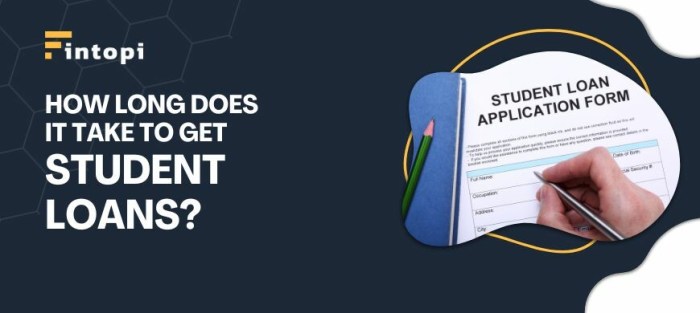
Securing funding for higher education is a crucial step for many students, and understanding the timeline for receiving student loan disbursement is vital for effective financial planning. The process, however, isn’t always straightforward. Numerous factors, from lender policies to institutional procedures and even individual student actions, can significantly impact how quickly funds become available. This guide delves into the intricacies of student loan disbursement, providing a clear understanding of what to expect and how to navigate the process efficiently.
From the initial application to the final credit of funds, the journey can involve multiple steps and stakeholders. This detailed exploration will cover various loan types, highlighting differences in processing times and outlining strategies for expediting the process. We’ll examine the roles of lenders, educational institutions, and students themselves, offering practical advice and illustrative examples to help you better understand and manage your expectations.
Understanding Loan Types and Their Processing Speeds

The speed at which you receive your student loan disbursement depends significantly on the type of loan you’ve applied for. Federal student loans, offered through the government, generally have a more established and predictable process than private student loans, which are offered by banks and other financial institutions. Understanding these differences is crucial for managing your expectations and planning your finances effectively. This section will compare and contrast the various loan types and their associated processing times.
Federal student loans and private student loans follow different application and approval processes, resulting in varying disbursement timelines. Federal loans often have a more streamlined application process due to established government procedures and standardized documentation requirements. In contrast, private loan applications can be more complex and involve more rigorous credit checks and income verification, potentially extending the processing time.
Federal Student Loan Disbursement Timelines
Federal student loans are categorized into subsidized, unsubsidized, and PLUS loans. Each type has its own specific requirements and processing timeline. Subsidized loans, for example, are need-based and the government pays the interest while the student is enrolled at least half-time. Unsubsidized loans, on the other hand, accrue interest from the time of disbursement, regardless of enrollment status. PLUS loans are loans for parents or graduate students. While the application processes are similar, minor differences in verification and eligibility checks can slightly affect processing times. Generally, federal loan processing times range from a few weeks to several months, depending on factors such as the completeness of the application and the time of year. For example, applications submitted during peak periods, like the start of the academic year, may take longer to process.
Private Student Loan Disbursement Timelines
Private student loan disbursement timelines vary widely depending on the lender and the applicant’s financial profile. Unlike federal loans, private loans are subject to credit checks and income verification, which can significantly impact processing speed. A strong credit history and stable income generally lead to faster approval and disbursement. However, applicants with less-than-perfect credit scores or limited income may face delays or even loan denials. Additionally, the lender’s internal processing procedures and volume of applications can influence disbursement times. Private loan processing can take anywhere from a few weeks to several months, sometimes longer, depending on these various factors.
Documentation Requirements and Their Impact on Processing Speed
The required documentation varies significantly between federal and private student loans. Federal loans typically require a completed FAFSA (Free Application for Federal Student Aid) form and verification of enrollment. PLUS loans may require additional documentation related to parental income and credit history. Private loans, however, often necessitate extensive documentation, including tax returns, bank statements, proof of income, and sometimes even a co-signer’s financial information. The completeness and accuracy of these documents directly affect the processing speed. Incomplete or inaccurate information leads to delays and requests for additional documentation, prolonging the overall disbursement timeline. Submitting all required documents promptly and accurately is crucial for minimizing processing time for both federal and private student loans.
Student Responsibilities and Actions

Receiving your student loan disbursement quickly depends significantly on your proactive engagement and attention to detail. Taking the necessary steps to ensure your application is complete and accurate will minimize processing time and alleviate potential delays. This section Artikels key actions students can take to expedite the process.
Expediting the Loan Disbursement Process
Students can significantly speed up the loan disbursement process by promptly completing all required steps. This includes submitting a fully completed application, providing all necessary documentation, and actively monitoring the application’s progress. Regularly checking your student portal and responding promptly to any requests from the financial aid office are crucial steps. For example, if the institution requests verification of income, providing this information immediately will prevent unnecessary delays. Proactive communication with the financial aid office can also help resolve any issues quickly.
Tracking Loan Application Status
Tracking your loan application status is straightforward with most institutions providing online portals. A step-by-step guide is as follows:
- Log in to your student portal: Access your institution’s online student portal using your login credentials.
- Navigate to the financial aid section: Locate the section dedicated to financial aid or student loans.
- Access your loan application: Find your specific loan application within the financial aid section.
- Review the status updates: The portal will typically display the current status of your application, indicating the stage of processing.
- Check for notifications: Regularly check for emails or messages from the financial aid office regarding your application status or any required actions.
Ensuring Accurate and Complete Documentation
Submitting accurate and complete documentation is paramount. Before submitting any documents, carefully review all forms for completeness and accuracy. Ensure all required signatures are present, and double-check that all information matches your application. Discrepancies can lead to delays. For instance, a mismatch in your social security number between the application and supporting documents will trigger a review, delaying disbursement. Make copies of all submitted documents for your records.
Common Student Errors and How to Avoid Them
Several common errors can delay loan disbursement. Understanding these errors and implementing preventative measures is essential.
- Incomplete Application: Ensure all sections of the application are fully completed and accurately filled out before submission.
- Missing or Incorrect Documentation: Carefully review the required documentation list and ensure all documents are submitted in the correct format and are legible.
- Inaccurate Information: Verify all personal and financial information for accuracy. Any discrepancies can lead to delays in processing.
- Failure to Respond to Requests: Promptly respond to any requests from the financial aid office for additional information or clarification.
- Incorrect Bank Account Information: Double-check your bank account details to ensure accuracy to avoid disbursement issues.
Illustrative Examples of Disbursement Timelines
Understanding the timeframe for receiving student loan funds can vary significantly depending on several factors. These examples illustrate realistic timelines under different scenarios, offering a clearer picture of what borrowers might expect. Remember that these are examples, and actual processing times may differ based on individual circumstances and the lending institution.
First-Time Borrower with Federal Direct Subsidized Loan
This example follows a first-time college student applying for a Federal Direct Subsidized Loan. The student completes the FAFSA (Free Application for Federal Student Aid) in February, is accepted to the university in March, and the university certifies their loan application in April.
The disbursement timeline might look like this:
- April – May: Loan application processing by the university and the Federal Student Aid (FSA) system. This includes verification of the student’s information and eligibility.
- May – June: Loan approval and disbursement. Funds are typically disbursed directly to the university in two installments, one at the beginning of the fall semester and the other at the beginning of the spring semester.
Returning Student with Federal Direct Unsubsidized Loan and Prior Loan History
This scenario involves a student who has previously borrowed federal student loans and is now applying for an unsubsidized loan for their second year of graduate studies. They submitted their FAFSA and loan application in July. Their prior loan history is already on file.
The disbursement timeline in this case could be:
- July – August: Loan application processing is generally faster for returning students with established credit history. The university’s financial aid office reviews the application, and the student’s prior loan history is quickly verified.
- August: Loan approval and disbursement. Because the student’s information is already in the system, approval is quicker. Funds are typically disbursed directly to the student’s account in one lump sum, as per their university’s disbursement policy.
Private Loan Application for an Undergraduate Student
This example features a student applying for a private student loan to cover their tuition expenses at a private university. The student applies in June. Private loan processing often involves a more rigorous credit check and application review.
The disbursement timeline might be:
- June – July: The student completes the private loan application, providing necessary financial information and undergoing a credit check (if applicable). The lender reviews the application and requests additional documentation if needed.
- July – August: Loan approval (if approved). The lender may require additional documentation or verification. Once approved, funds are disbursed to the university according to the disbursement schedule set by the university and the lender. This process can take longer than federal loan processing due to additional checks and verification steps.
Last Point

Obtaining student loan funds involves a multi-faceted process with varying timelines depending on several interconnected factors. By understanding the roles of lenders, institutions, and students, and by proactively addressing potential delays, students can significantly improve their chances of receiving their funds in a timely manner. Remember to carefully review all documentation, maintain open communication with your lender and institution, and promptly address any requests for additional information. Proactive engagement and meticulous attention to detail are key to a smoother and faster disbursement process.
FAQs
What happens if my school doesn’t receive my loan information on time?
Contact your school’s financial aid office immediately. Delays in receiving information from the lender can significantly impact disbursement. They can help troubleshoot the issue and potentially expedite the process.
Can I get my loan faster by choosing a specific lender?
Lender processing times vary. While some lenders may advertise faster processing, this isn’t always guaranteed. Choosing a reputable lender with a clear and transparent process is more important than focusing solely on speed.
What if I made a mistake on my loan application?
Contact your lender immediately to correct any errors. Addressing mistakes promptly can prevent significant delays. Be prepared to provide supporting documentation to rectify the issue.
How can I track the status of my loan application?
Most lenders and educational institutions provide online portals or tools to track application status. Regularly check these portals for updates and notifications. Contact your lender or school if you cannot find the necessary information.
